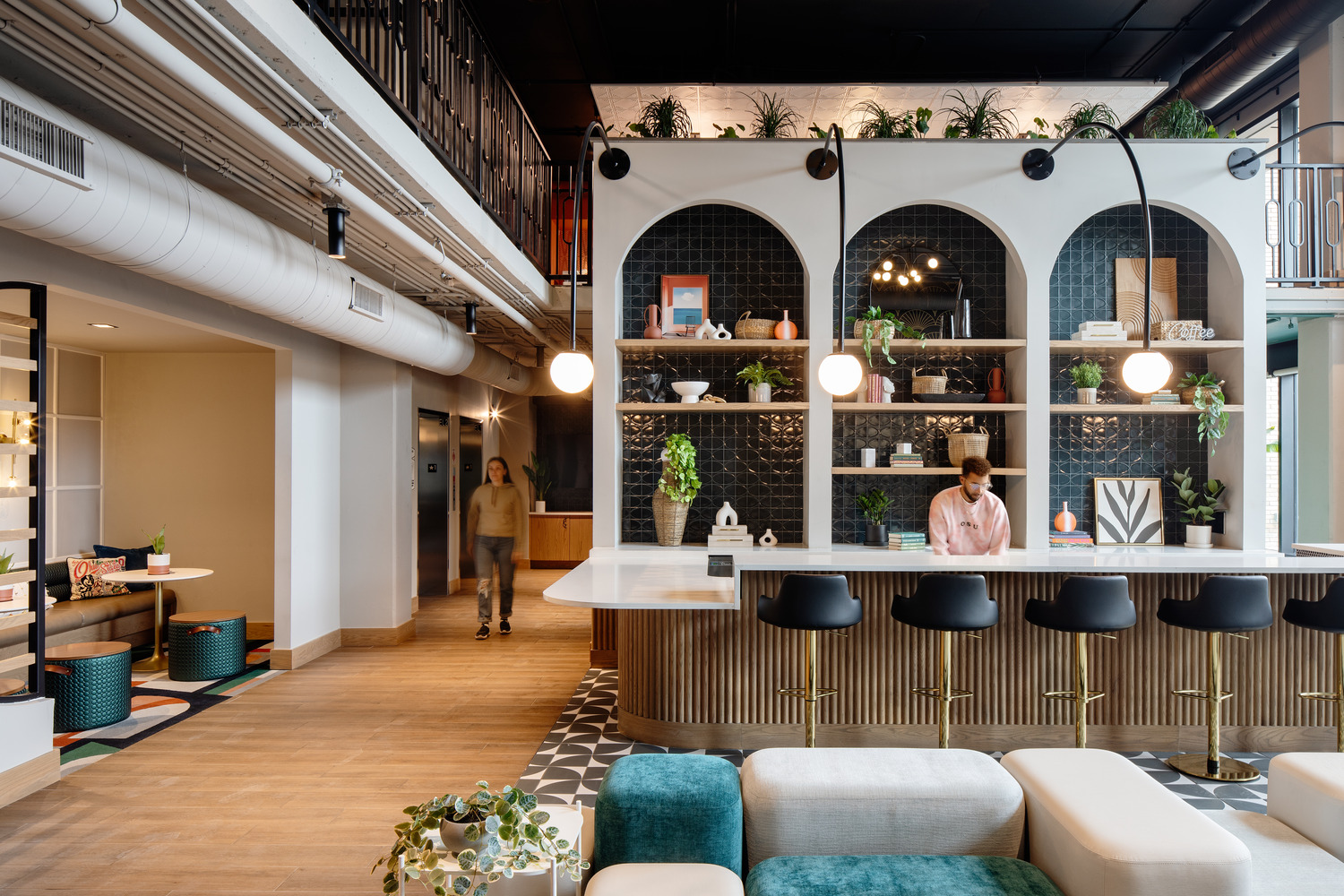As student populations grow and on-campus housing remains limited, off-campus housing has become a critical part of the higher education experience. According to Propmodo, the demand for student housing greatly exceeds supply at many universities, making the asset class an unlikely real estate kingmaker over the past two decades. But this growing reliance has brought on new challenges.
While the first-year dorm experience is often rich in social interaction and university programming, the transition off campus can come with a steep decline in connection, support, and engagement. A column in The Daily Gamecock, the University of South Carolina’s student newspaper, put it plainly: “Off-campus housing can be isolating.” When students move off campus, they risk losing the daily rhythms and casual relationships that make college life feel cohesive. This raises a fundamental question for developers and designers alike: How can we ensure off-campus housing supports, not undermines, a student’s experience and well-being?
Putting Connection First in Off-Campus Housing Design
The best off-campus housing doesn’t just provide a place to live, it creates the conditions for connection. At VERVE West Lafayette, developed by Subtext near Purdue University, that philosophy takes center stage. Every detail of the building reflects Subtext’s broader “Unlonely Mission,” a commitment visible across other recent developments in Bloomington, Boise, and Columbus. All elements of the project are shaped by a singular mission: to unlonely student life. This shows up not just in the operations, but in the physical spaces themselves.
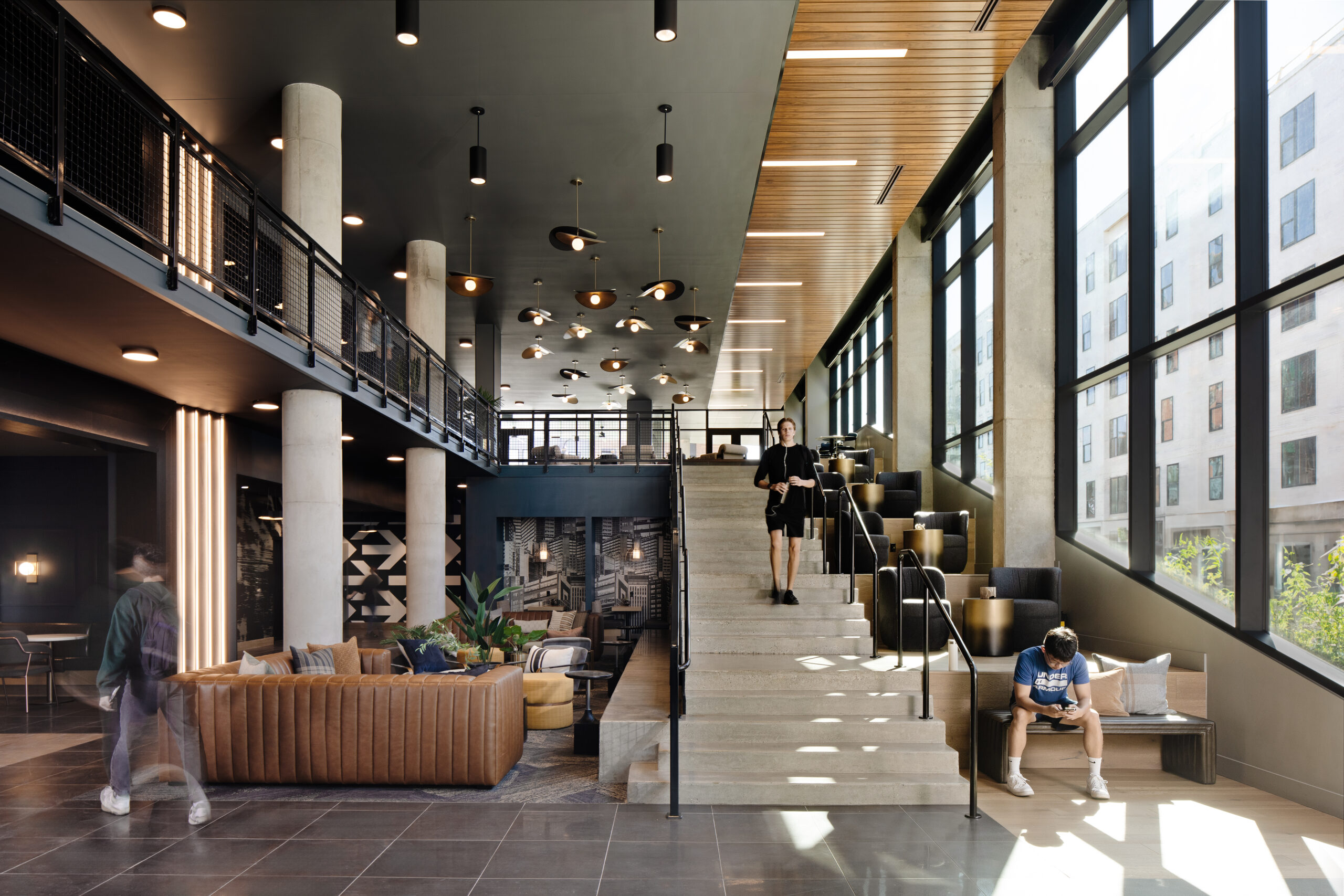
Verve West Lafayette
From the moment residents arrive, they’re greeted by a friendly team member at a vibrant leasing bar that doubles as a coffee spot by day and transforms into a social lounge by night. Upstairs, amenities include wellness-forward features like a yoga studio, sauna, and meditation spaces that prioritize mental health without feeling clinical. A bold design move, like a swirling slide connecting two floors, adds a touch of playfulness and sparks spontaneous interaction among residents.
There’s also an intentional balance between private and public. Study pods provide a quiet retreat, while common areas offer room for collaboration and friendship. Local design cues, from materials to murals, tie the space to the community to help students feel rooted in both place and purpose. And with a walkable location just minutes from Purdue’s campus, VERVE keeps students close to the heart of university life, even when they live beyond its footprint.
Design Strategies to Build Belonging Off-Campus
Creating a sense of belonging is essential for student success and well-being, especially in off-campus housing where students can feel socially and physically disconnected. Design plays a pivotal role in bridging this gap by encouraging interaction and fostering inclusive communities. Layered communal spaces like study lounges, community kitchens, maker spaces, fitness areas, and rooftop terraces support both structured and sporadic engagement. Semi-private “threshold” areas, such as shared entryways, floor lounges, or front porches, can facilitate passive interactions and foster the formation of micro-communities.
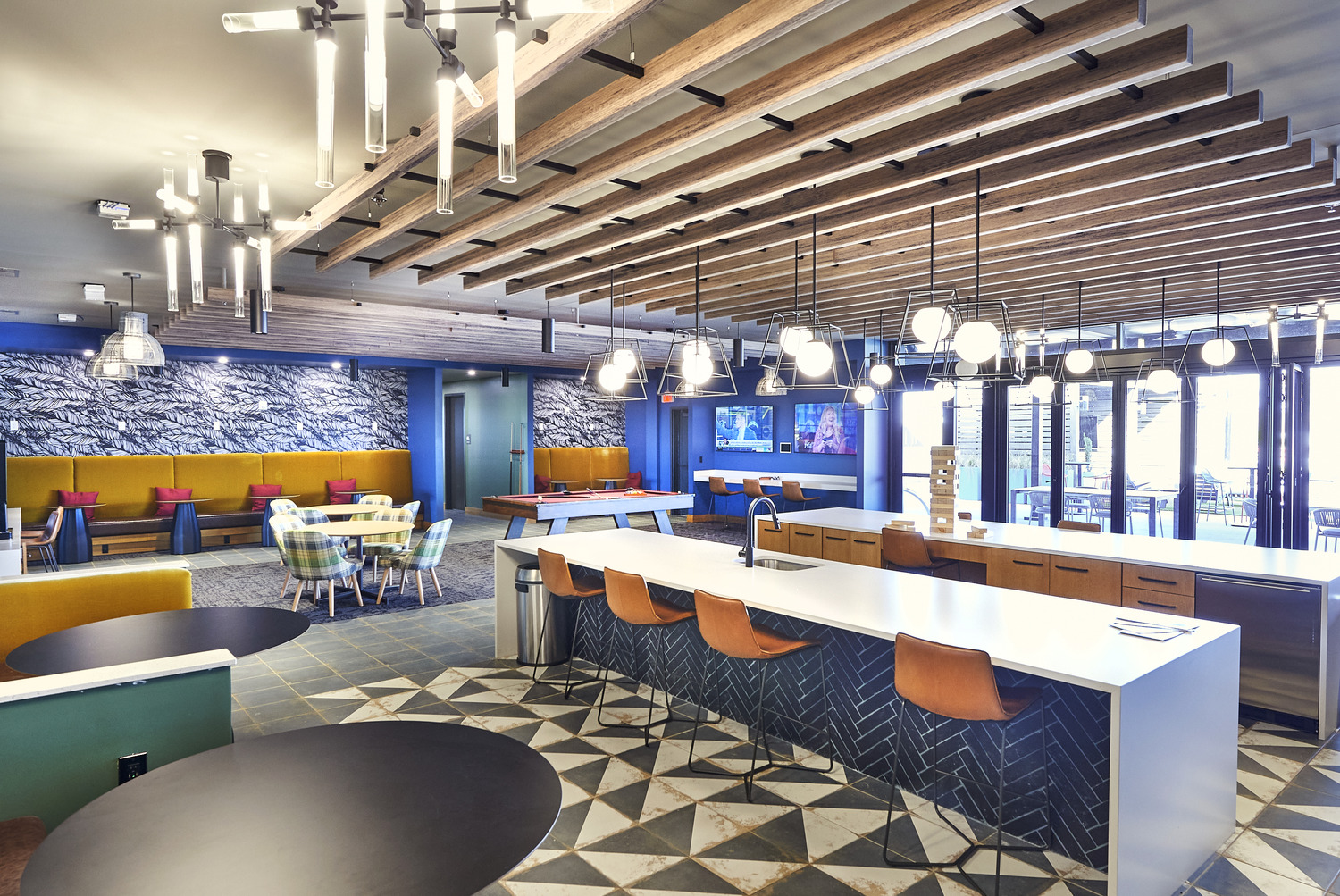
Verve Bloomington
Attention to scale and proximity is also essential. Breaking down large buildings into smaller “neighborhoods,” for instance, clusters of units sharing a lounge or “pods” with common amenities, helps cultivate a more intimate residential experience. Circulation spaces should be designed to encourage visibility and activity through features like open stairwells, transparent walls, and generous natural light.
Additionally, inclusion must be embedded from the start. Universal design features, like all-gender restrooms, multi-faith meditation rooms, and accessible layouts, signal that every student is welcome. But belonging also comes from the process. Early engagement through participatory design workshops, such as collaborative charrettes that use storyboarding, spatial mapping, or card-sorting exercises, can reveal latent needs and values.
Beyond the initial phases, ongoing feedback loops, through student advisory panels or milestone surveys, ensure that evolving expectations are acknowledged. Post-occupancy evaluations offer valuable insight into what worked, what didn’t, and what students wish had been included, providing direction for future projects. Partnerships with Student Affairs can surface less-visible insights, especially for underrepresented grounds, and collaborating with departments such as housing, DEI offices, or cultural centers helps ensure the design reflects the full spectrum of student experiences.
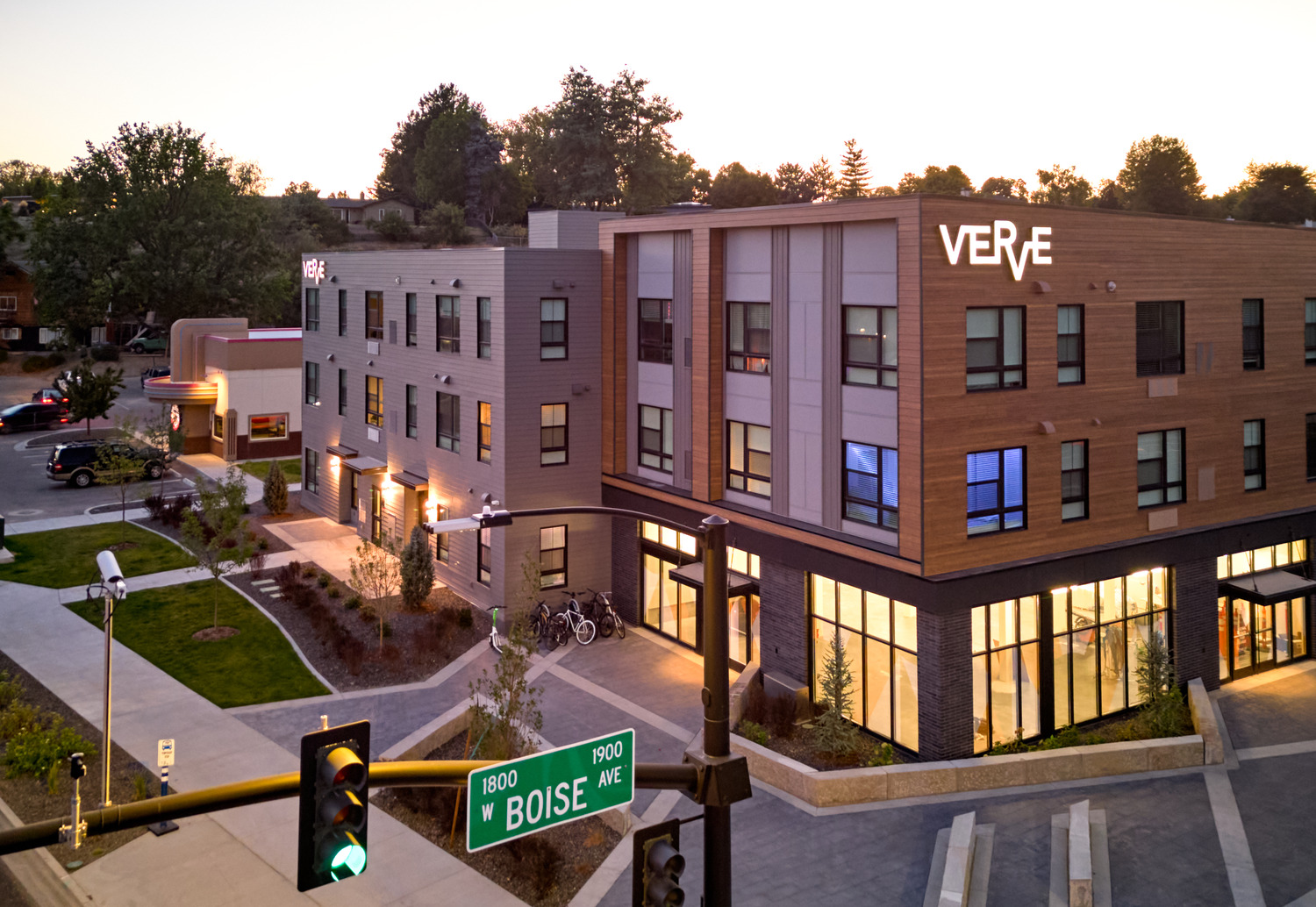
Verve Boise
The building’s location and its access to campus and neighborhood matter just as much. Well-lit walking paths, secure bike infrastructure, and proximity to transit support easy movement, while ground-floor retail or community-facing programming can integrate student housing into the fabric of the neighborhood. Visual and programmatic links to campus, views of landmarks, spaces for student orgs, and campus-branded graphics reinforce psychological connectivity. Ultimately, off-campus housing that offers informal third spaces, integrates wellness through design, and supports events like shared meals or club meetings becomes more than a place to live – it becomes a platform for unity, identity, and student growth.
A Call to Align
For the growing number of students living off campus, the line between inclusion and isolation often comes down to how their housing is designed. Developers, designers, and campus leaders must work together to meet students where they are, both physically, socially, and emotionally.
Off-campus doesn’t have to mean disconnected. In fact, with intentional design, it can be a powerful extension of campus life. By aligning priorities and centering connection, we can ensure that student housing continues to support, not interrupt, a student’s college journey.
Get to Know Our Student Housing Team
Our Higher Education designers share why they’re excited about the future of student housing – from rising global demand to an increasing desire for sustainable design – and what they enjoy most about their work.

Ankrom Moisan’s Student Housing Team (From left to right, starting in the back row: Jason Jones, Jenna Mogstad, Matt Janssen. Front row: Cindy Schaumberg, Alex Kuzmin, Mackenzie Snyder, Zach Stofferahn, Sydney Ellison)
Jenna Mogstad
4 Years
Associate Interior Designer
What do you like best about designing student housing?
I love it because it’s FUN. Student housing is invigorating and creative, with really unique requirements and programs to consider. Designing spaces that inspire and cater to young adults and users that are in such a formative stage of their life is really rewarding.
What has excited you about future work in this sector?
I’m most excited about incorporating trauma-informed design principals into student housing and higher education projects. Creating safe and non-triggering spaces for users from every possible background is something I take very seriously. We need to ensure that this population can thrive and be successful, for the future of us all.
What interesting changes have you seen in this sector over the years?
Since I graduated college in 2017, I’ve seen a big shift in the level of amenities that are provided in student housing. Each new project seems to just get better and better in terms of the activities and spaces that students are offered – right in their homes. Bars, theaters, spas, fitness, you name it. There’s a whole new level of approachable luxury that didn’t exist even just a short time ago when I was a student. It’s really exciting to see!
Mackenzie Snyder
1 Year
Interior Designer
What do you like best about designing student housing?
There are endless possibilities to be creative through finishes (fun colors, patterns, textures, etc.) and functions of a space (feature stairs with integrated seating, rock climbing walls and fun fitness zones, variations in study areas, etc.).
What has excited you about future work in this sector?
I like that this sector will always give us the opportunity to help create environments that help young students feel comfortable in the process of moving away from home and going through formative new steps in their life. The fact that design can help make that transition smooth is something that will never change, even as other trends do.
Is there anything that makes you uniquely suited to working in this sector?
I’m the youngest on the team and therefore the most recently out of college. I think because of that I can bring a unique perspective. I’m close to the current generation of students and can see firsthand how they tend to interact in their college environments. That can be very useful.
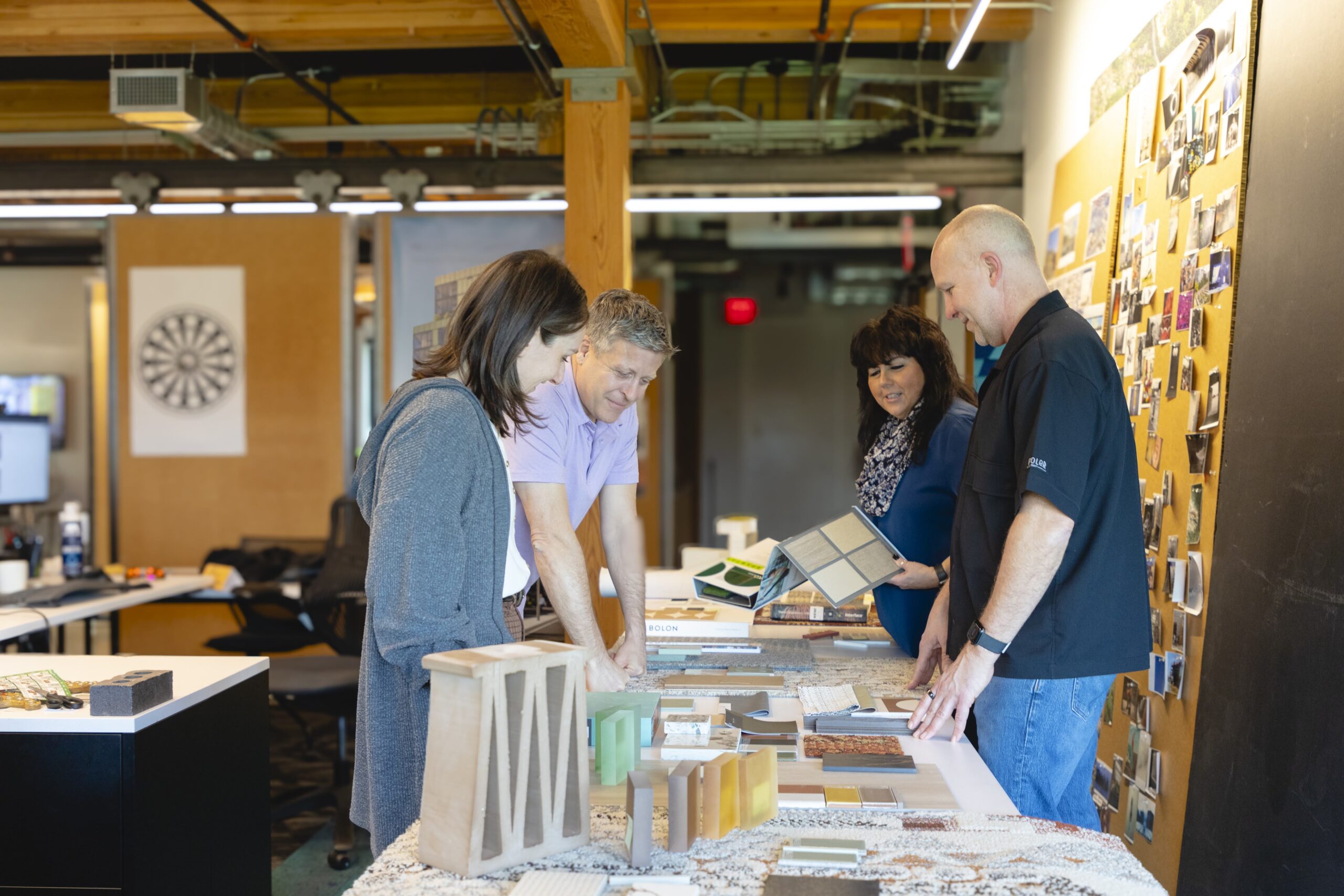
Sydney Ellison, Jason Jones, Cindy Schaumberg, and Matt Janssen at a design charette.
Zach Stofferahn
3 Years
Job Captain
What do you like best about designing student housing?
Student housing has a much bigger focus on communal spaces than a typical multi-family project.
What has excited you about future work in this sector?
I have seen several student surveys indicating sustainability is important to students today. We are always looking for ways to incorporate sustainable features into our buildings, so it is exciting to work with a user group that shares that value. I am hopeful that as students continue to seek those features, our design solutions can become more and more bullish on sustainability.
What’s uniquely challenging about designing student housing?
Schedule is important on all projects, but in student housing even more so because it is so critical to align building completion with the academic calendar. Pushing the schedule is typically not an option.
Sydney Ellison
6 Years
Interior Designer
What do you like best about designing student housing?
Getting to be very playful with our designs.
What has excited you about future work in this sector?
I’m excited by the increasing focus on mental health and wellness being integrated into off-campus housing.
What inspires you?
Our higher-ed team is inspiring; we have a great dynamic and collaborative environment.
Alex Kuzmin
3 Years
Technical Designer, Project Architect
What do you like best about designing student housing?
There are unique opportunities to be creative that don’t present themselves in other market sectors. I enjoy striking that delicate balance with budget and client expectations.
What has excited you about future work in this sector?
Rising global demand. With a projected 594 million higher education students by 2040, our studio is uniquely positioned to capitalize in this market sector with our experience and specialized knowledge base.
What’s uniquely challenging about designing student housing?
Designing student housing is uniquely challenging because you need to strike a balance when considering functional, flexible spaces with the design of an engaging, communal environment that supports both academic and social development.
Want to get to know the Higher Education Studio leaders? Hear from Cindy Schaumburg and Jason Jones here. Hear from Matt Janssen and Alissa Brandt here.






